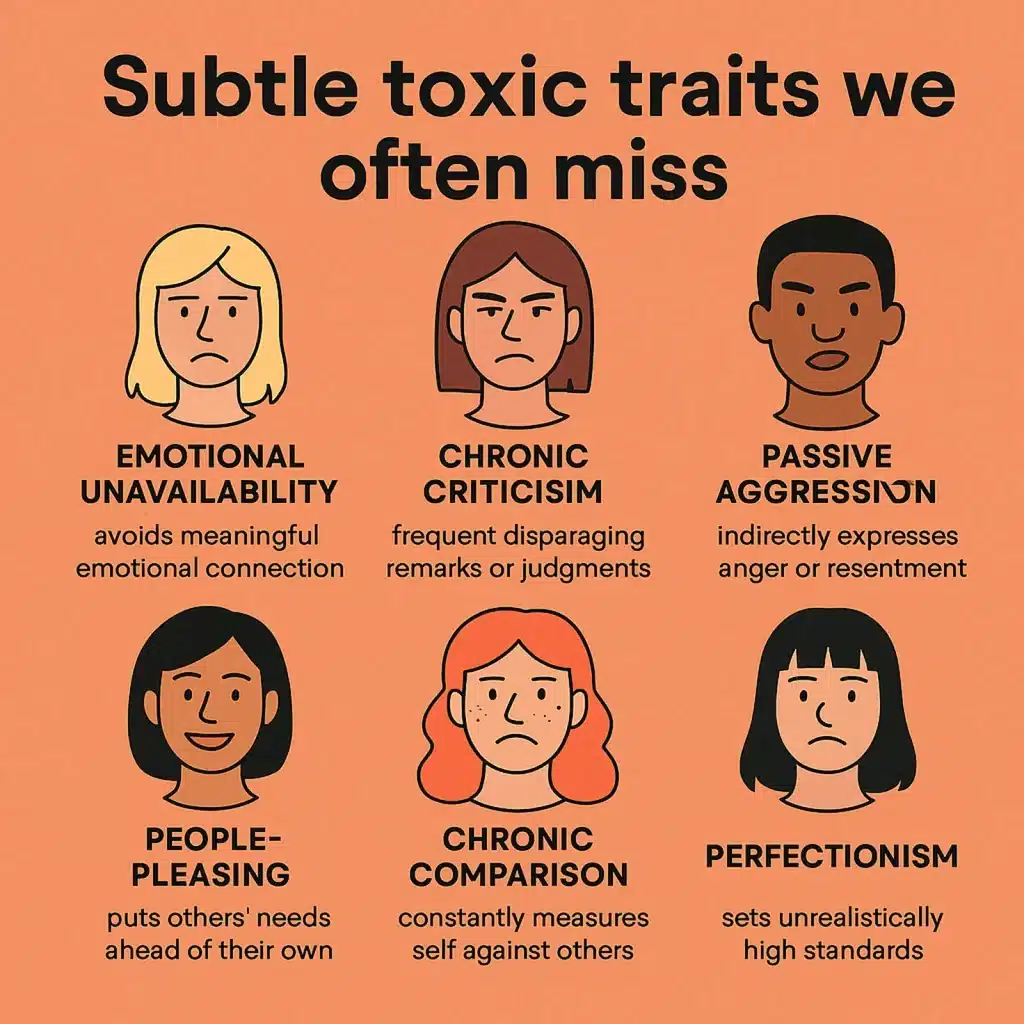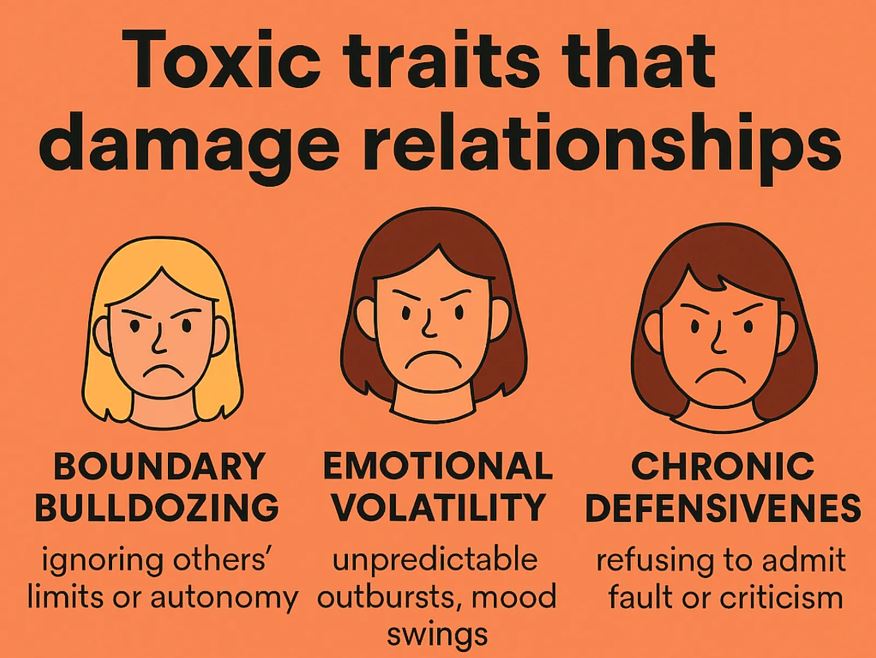Toxic Traits: What They Really Are (Why We All Have Them) (Part 1)
 Did you know most people repeat harmful patterns for years before ever seeing them? But really, most people never see them until life slaps them in their face!
Did you know most people repeat harmful patterns for years before ever seeing them? But really, most people never see them until life slaps them in their face!
How about this? You’re mindlessly scrolling on your phone while lunch gets cold, caught up in useless stuff most likely. Twenty minutes disappear. You can’t remember what you saw, it’s as if you were unconscious.
These small moments show how automatic patterns steal your life away. One moment at a time. These things seem trivial, right? But they are not
That’s the thing about toxic traits. Most advice gets it all wrong. People think toxic traits are “bad habits” you can willpower away. But these patterns run deeper. They’re wired into your very brain through years of practice, and they beat the crap out of will power every single time.
What Toxic Traits Really Are
When people hear “toxic traits,” they picture obvious bad guys. Manipulators. Narcissists. Abusers. But toxic traits are way more common. Way more human. We all have them, you might tell yourself ‘oh that’s just how I am’, but honestly, they are things we have just allowed to stick to us that are stealing away our joy.
Toxic traits aren’t character flaws that make someone “bad.” They’re learned responses, defense moves that once helped but now hurt.
They don’t announce themselves with warning signs. They operate in blind spots, lurk in the shadows. These sneaky poisons we carry without knowing.
Here’s what nobody tells you about toxic traits. They don’t start toxic. They actually begin as survival strategies in response to difficult life situations, and often times there is just no choice for us. The human brain is truly a wonderful think, it adapts and shapes itself depending on what it experiences.
- The kid who learned being perfect got love now becomes the adult who can’t relax.
- The teenager who found controlling everything felt safer becomes the micromanager that pisses everyone off
- The young girl who discovered helping everyone made her needed becomes the people-pleaser who burns out.
Sound familiar? Yeah, thought so.
These patterns made sense when they started. A five-year-old trying to keep angry parents happy through perfect behavior. A teenager managing chaos by controlling what they could. An adult avoiding abandonment by being needed. When we’re at that age, we don’t really have the emotional intelligence and discernment to deal with difficult stuff life throws at us. So the brain jumps in to help.
But what works at five might destroy relationships at thirty-five.
 Think about it this way. Your brain is like a hiking trail. Walk the same path over and over and the trail gets deeper. Eventually, that path becomes automatic and hard wired. You don’t choose it anymore. Your feet just follow. That pattern is now hidden below the ‘conscious mind’.
Think about it this way. Your brain is like a hiking trail. Walk the same path over and over and the trail gets deeper. Eventually, that path becomes automatic and hard wired. You don’t choose it anymore. Your feet just follow. That pattern is now hidden below the ‘conscious mind’.
Toxic traits are mental hiking trails worn so deep they feel like the only way.
Common Signs You Might Have Toxic Traits:
- Feeling drained and depleted after hanging out with people
- Noticing arguments follow similar patterns
- Saying sorry for “who you are” instead of what you did
- Putting yourself last
Studies show something important. Toxic traits create feedback loops and your protective behaviors often create the exact problems you’re trying to avoid. Scary and true!
When you act defensive, others get defensive too. When you try controlling everything, you often create more chaos. When you people-please to avoid conflict, you build anger that explodes later.
It’s like trying to put out fire with gasoline.
The Most Common Toxic Traits (You Might See These)
Let’s call these patterns what they are. Not to shame anyone. But because naming something gives you power over it.
Emotional Unavailability
 This one’s really, really hard to spot from inside. You’re physically there but emotionally miles away, you’ve checked out. You nod. Say the right things. But keep an invisible wall up.
This one’s really, really hard to spot from inside. You’re physically there but emotionally miles away, you’ve checked out. You nod. Say the right things. But keep an invisible wall up.
Picture someone sharing something vulnerable with you. They’re opening their heart, but you’re already planning your response, or thinking about dinner. Or just somewhere else entirely. Basically, you are not present. You might be saying, ‘oh no, I don’t do that’. Well, you most likely do, you just haven’t spotted it
You’re not doing this to be cruel. Behind that wall, you’re often starving for connection. But terrified of it too.
Ever notice how exhausting it is to keep people at arm’s length? How much energy it takes to stay guarded when part of you desperately wants closeness?
Chronic Criticism
We all know someone who walks into a beautiful room and spots the one flaw, and brings everyone down.
This isn’t about having standards. It’s about making peace impossible.
Living with chronic criticism means never being satisfied or happy, a constant state of ‘not enoughness’. Always scanning for what’s wrong. Missing moments of joy while hunting for problems.
The friend who can’t take a compliment without deflecting. “Nice presentation,” you say. “yeah but I messed up the third slide though,” they respond immediately.
How much life gets missed while focused on flaws?
Passive Aggression
This trait is sneaky. Really, really sneaky. It’s expressing anger sideways instead of directly, it’s a cowardly trait.
The sarcastic comments. Subtle digs. Silent treatment. “I’m fine” when clearly things are not fine.
Picture this. Your partner suggests changing dinner plans. Instead of saying “oh I’m disappointed,” you give them the cold shoulder all evening, silent and distant. When they ask what’s wrong, you are abrupt and say “nothing” in a tone that clearly means “everything.”
People who do this aren’t being mean on purpose. They learned early that direct conflict felt dangerous. So they developed sideways methods of expressing feelings.
The problem? Issues never get solved when they’re addressed sideways.
People-Pleasing
This one disguises itself as kindness. That makes it extra tricky to spot. I think most of us have this trait to some degree.
It’s always putting others’ needs before your own. The chronic knee jerk “yes” when you mean “no.” Never expressing disagreement. Exhausting yourself trying to manage everyone else’s emotions.
People-pleasers think they’re being selfless and loving. Really, they’re trying to control outcomes. Making sure everyone likes them as protection against being abandoned
The cost? Your health suffers from chronic stress. You have no idea what you actually want. Your relationships lack real closeness because you never show up as yourself.
And of course, there is that simmering, bubbling anger building when you constantly override your own needs, have you noticed that? That growing sense of martyrdom that eventually poisons the relationships you’re trying to protect?
Chronic Comparison
Just constantly measuring yourself against others. Your looks. Achievements. Relationships. Possessions. The mental scorecard you are always running.
You’re at a friend’s celebration. But instead of being happy for them, you’re pissed off about how you’re falling short. Someone else’s win feels like your loss.
It’s so exhausting to live this way. Never able to appreciate your own journey. Never genuinely celebrating others because you’re too busy keeping score.
Perfectionism
Your mind convinces you that this is about high standards, but it goes way beyond. It’s the relentless and unhealthy pursuit of flawlessness. Harsh self-criticism for any mistake.
The cruel kick in the head? Perfectionism promises protection from criticism and failure. But it actually guarantees them, because perfection is impossible. You can never get to where you are trying to.
The perfectionist becomes their own harshest critic. What starts as wanting approval becomes a prison of never being good enough.
Have you noticed how perfectionism creates exactly what it’s trying to avoid? How it increases anxiety instead of reducing it?
Boundary Bulldozing
 These are people allergic to the word “no.” They treat your limits like opening negotiations. “But I thought we were close” or “if you really cared, you would…”
These are people allergic to the word “no.” They treat your limits like opening negotiations. “But I thought we were close” or “if you really cared, you would…”
They press for “just five minutes” and railroad you when you say you can’t talk. Find sneaky ways to bring up topics you said were off-limits. Push and push until you give in.
The painful irony? This behavior pushes away the very connection it’s trying to secure. People don’t move closer to those who ignore their limits. They create distance to protect themselves.
Emotional Volatility
This involves emotions that seem way too big for the situation. Small disappointments spiral into hours of tears. Minor frustrations explode into rage. The mole hill is made into a mountain.
It creates a walking-on-eggshells atmosphere. Everyone becomes constantly alert, scanning for signs of the next emotional storm.
This isn’t about lack of self-control. It’s about never learning how to handle emotions internally. When feelings aren’t processed gradually, they emerge as overwhelming floods.
The most painful part isn’t the big reactions, it’s the shame afterward. The apologies. The promises to do better. The growing sense that something is fundamentally wrong with you.
Chronic Defensiveness
You see any feedback as an attack. Moving immediately to justification or counter-attack when faced with even gentle questions.
It’s really, really disturbing to recognize in yourself. At a workshop, one person described watching themselves on video during an argument. They were shocked by how quickly they shifted to defense mode. Interrupting. Justifying. Counter-arguing. Never actually listening. is like you just drop into this version of yourself that you don’t recognize.
Defensiveness creates a terrible cycle. The more defensive you are, the less others can communicate honestly. it just means issues don’t get solved and this creates more situations that trigger defensiveness.
What all these traits share: They develop as protection against vulnerability. But they end up as misguided attempts to shield us from the risks of genuine connection and emotional honesty.
That’s why they’re so painful. They actually keep us from the very experiences that would heal our original wounds.
Why We Keep Repeating Toxic Patterns (Even When We Know Better)
Here’s the frustrating truth. There’s a big difference between knowing something in your head and knowing it in your beingness.
Your conscious mind can understand that a pattern is harmful. But your nervous system still believes it’s necessary for survival. This is where the conflict exists, you consciously want to change, but your body resists.
When toxic traits developed, they were helpful responses to your environment. Your brain formed strong pathways around these behaviors. They became automatic. They became your conditioning
Breaking these patterns isn’t just about deciding to change. It requires rewiring your nervous system. Changing core beliefs. Learning new emotional responses. This is why it’s so frustrating and difficult to do.
Think about it like this. Your new awareness is maybe a few months old. But this pattern has been practicing for decades. You need to give the new part time to grow stronger.
Life has a way of shaking us up when we need it most. When we’ve become too comfortable with patterns that don’t serve us anymore.
First it throws pebbles to get your attention. If you ignore those, it throws rocks. Ignore those, and it throws bigger rocks. Then boulders. Eventually, life throws an island on your head to wake you up.
Be patient with yourself. Healing happens in layers. Going backward sometimes is part of moving forward. It’s not evidence of failure.
The fact that you’re reading this means you’ve already taken the most important step. You’re willing to look at your patterns honestly.
And that’s when everything changes.
Remember: Awareness is always the first step toward change.
Moving Forward: What’s Next
Understanding toxic traits is just the beginning. In Part 2, we’ll explore how past wounds create these patterns. How relationships expose our most hidden behaviors. The roots beneath the surface that keep these traits alive.
For now, practice noticing without judgment, don’t go beating yourself up, it doesn’t help. When do these traits show up in your daily life? What triggers them? What are they trying to protect?
You’re not trying to fix everything today. You’re just beginning to see clearly.
Why do we hide these parts of ourselves? Acknowledging toxic traits doesn’t make us worse people, it’s actually the path to becoming better ones?
The journey from toxic traits to authentic strength starts with honest recognition. You’ve already begun.
Let me be completely honest with you here.
The most powerful shift comes when you stop asking “What’s wrong with me?” and start asking “What is this pattern trying to protect?” The first question invites shame. The second invites healing.
Quick Self-Check: Do Any of These Toxic Traits Show Up in You?
We all pick up coping behaviors along the way — some of them helpful, some quietly harmful. Answer honestly — this isn’t about judgment, it’s about self-awareness.
✅ Rate each statement from 1 (Rarely) to 5 (Often):
-
I avoid emotional closeness or find it hard to open up. (Emotional Unavailability)
-
I frequently compare myself to others, especially online. (Chronic Comparison)
-
I often agree to things I don’t want to do, just to keep the peace. (People-Pleasing)
-
I struggle to take feedback without becoming defensive. (Chronic Defensiveness)
-
I make sarcastic or subtle jabs when I’m upset, instead of expressing it directly. (Passive Aggression)
-
I feel pressure to get everything just right, and get frustrated when I don’t. (Perfectionism)
-
I have trouble respecting others’ emotional or physical boundaries. (Boundary Bulldozing)
-
My moods change quickly, and I can become emotionally intense or reactive. (Emotional Volatility)
-
I catch myself being overly critical — of myself or others. (Chronic Criticism)
Now tally your answers:
-
9–17: You likely have healthy boundaries and self-awareness. Keep reflecting and growing.
-
18–31: Some subtle toxic traits may be showing up. Not a flaw — just a signal for gentle reflection.
-
32–45: These patterns might be affecting your relationships more than you realize. Time to explore the roots — and how to shift them.
FAQs
For a deeper look at common toxic behaviors and how to recognize them, visit this guide from Psych Central.
Why do toxic traits feel so automatic?
Toxic traits become automatic because they’re practiced, entrenched brain pathways. Your brain creates shortcuts for behaviors it thinks you need. After years of repetition, these patterns bypass conscious choice entirely. They activate faster than you can think about them.
Can someone have toxic traits and still be a good person?
Yes! Absolutely. Toxic traits are learned behaviors, not character judgments. Good people can have harmful patterns they’re unaware of. The willingness to recognize and work on these traits actually shows strength and integrity, not weakness.
How do I know if my behavior is toxic or just part of my personality?
Toxic traits typically cause recurring problems in relationships or persistent distress to yourself or others. They feel rigid and automatic rather than chosen. Healthy personality traits enhance your life and connections, while toxic traits create ongoing friction and suffering.
The Hidden Pain Behind Toxic Traits: Where They Come From (Part 2)






